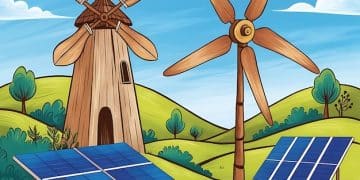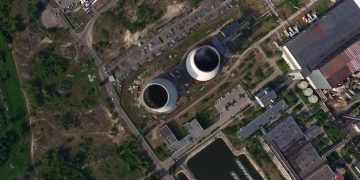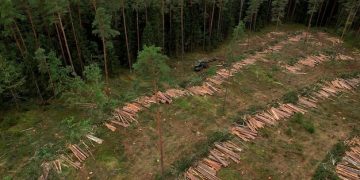Emerging Carbon Removal Technologies in the US: A Deployment Timeline
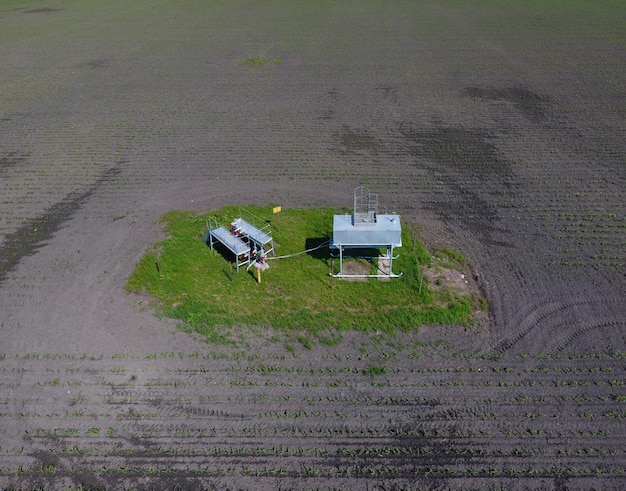
Emerging technologies for carbon removal in the US include direct air capture, enhanced weathering, bioenergy with carbon capture, and afforestation/reforestation, each at varying stages of development and deployment readiness, facing unique scalability and cost challenges.
The urgency of climate change demands innovative solutions, and carbon removal technologies are gaining traction in the US as potential game-changers. What are the Emerging Technologies for Carbon Removal in the US, and How Close Are They to Large-Scale Deployment? This article explores promising approaches and evaluates their current status.
Understanding the Need for Carbon Removal in the US
The United States, like many industrialized nations, faces the critical challenge of reducing its carbon footprint. While transitioning to renewable energy sources is essential, it is increasingly clear that simply reducing emissions will not be enough. Carbon removal, also known as negative emissions, involves capturing CO2 from the atmosphere and storing it permanently.
This approach is vital for achieving net-zero emissions targets and mitigating the effects of past emissions. The US government, along with numerous private companies, is investing in research and development to accelerate the deployment of these technologies.
Why Carbon Removal is Crucial
Carbon removal acts as a complement to emissions reduction. It’s crucial because of the historical carbon emissions that are already in the atmosphere, needing to be addressed.
Many climate models demonstrate that achieving global temperature targets, like the goals defined in the Paris Agreement, will require widespread implementation of carbon removal technologies.
- Addressing Legacy Emissions: Carbon already in the atmosphere continues to impact the climate.
- Offsetting Hard-to-Abate Sectors: Some industries, like aviation and agriculture, are difficult to decarbonize fully.
- Reaching Net-Zero: Achieving net-zero goals requires balancing emissions with removals.
Ultimately, carbon removal technologies offer a crucial pathway to a healthier planet by addressing the accumulation of greenhouse gases over the past centuries.
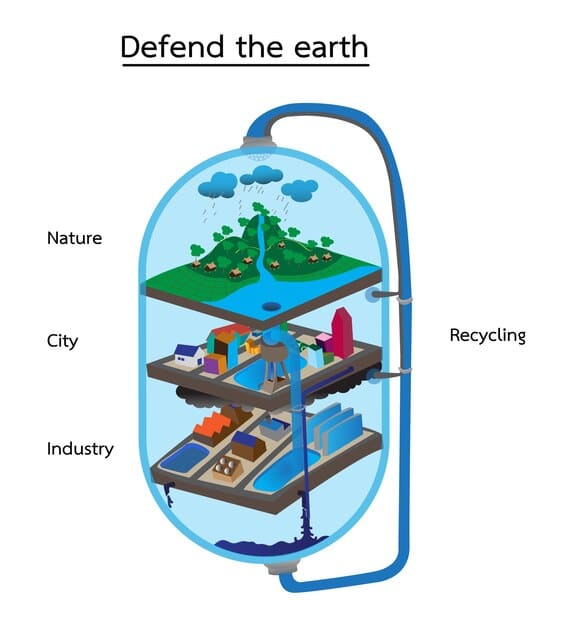
Direct Air Capture (DAC): Sucking CO2 from Thin Air
Direct Air Capture (DAC) is arguably one of the most innovative and talked-about carbon removal technologies. It involves using specialized machines to extract CO2 directly from the ambient air. This captured CO2 can then be stored underground or used in various industrial processes.
DAC offers the advantage of being deployable virtually anywhere, unlike technologies that rely on specific geographical features or biological processes. However, DAC is energy-intensive and currently expensive.
How DAC Works
DAC systems typically use chemical solvents or solid sorbents to bind with CO2 in the air. The CO2 is then extracted from the sorbent and compressed for storage or utilization.
The energy required to power DAC plants is a significant factor in determining its overall environmental impact. Ideally, DAC plants should be powered by renewable energy sources.
- Chemical Solvents: Absorb CO2 from the air, then release it when heated.
- Solid Sorbents: Bind CO2 to a solid material, releasing it under different conditions.
- Energy Requirements: The type of energy used drastically impacts the overall footprint of the technology.
The potential to scale DAC to gigaton levels makes it a key technology in achieving global climate goals. However, addressing the cost and energy intensity remains crucial for its widespread adoption.
Enhanced Weathering: Accelerating Nature’s Carbon Sink
Enhanced weathering involves accelerating the natural process of rock weathering to capture atmospheric CO2. This is achieved by spreading crushed silicate rocks on land or in the ocean, where they react with CO2 to form stable carbonates, essentially locking away the carbon.
This approach not only removes CO2 but can also improve soil fertility and ocean alkalinity. However, it requires significant mining and transportation of rocks, and the environmental impacts of these activities need careful consideration.
The Science Behind Enhanced Weathering
The natural weathering of rocks, a process that occurs over geological timescales, can be sped up through human intervention. Crushing rocks increases their surface area, enhancing their reaction with CO2.
When silicate rocks react with CO2, they form carbonates that can be stored indefinitely in the earth or ocean. This process can also release beneficial minerals into the soil or water.
- Silicate Rocks: React with CO2 to form stable carbonates.
- Spreading Methods: Rocks can be spread on land or in the ocean.
- Environmental Benefits: Improved soil fertility and ocean alkalinity.
The potential scalability and environmental benefits of enhanced weathering make it an attractive carbon removal option. However, logistical challenges and the environmental impact of rock mining and transportation need to be carefully managed.

Bioenergy with Carbon Capture (BECCS): Powering Up Carbon Removal
Bioenergy with Carbon Capture and Storage (BECCS) involves using biomass for energy production and then capturing the CO2 emitted during the process. The captured CO2 is then stored underground, resulting in negative emissions.
BECCS has the potential to provide both energy and carbon removal, making it an attractive option. However, it relies on the sustainable sourcing of biomass and the availability of suitable geological storage sites.
The BECCS Process
BECCS combines two technologies: bioenergy and carbon capture and storage. Biomass, such as trees or agricultural residues, is burned to produce electricity or heat. The CO2 released during combustion is captured and stored underground.
For BECCS to be truly effective, the biomass must be sourced sustainably, avoiding deforestation and competition with food production. The carbon capture and storage component must also be implemented safely and efficiently.
- Biomass Sourcing: Sustainable practices are crucial for BECCS effectiveness.
- Carbon Capture: Technologies capture CO2 from burning biomass.
- Geological Storage: CO2 is stored permanently underground.
The dual benefits of energy production and carbon removal make BECCS a promising technology, but its widespread implementation depends on addressing sustainability concerns and logistical challenges.
Afforestation and Reforestation: Nature’s Carbon Capture Solution
Afforestation and reforestation involve planting trees in areas where they did not previously exist (afforestation) or restoring forests that have been degraded or destroyed (reforestation). Trees absorb CO2 from the atmosphere as they grow, storing it in their biomass.
These natural solutions offer multiple benefits, including biodiversity conservation, soil stabilization, and water regulation. However, the amount of carbon that can be stored through afforestation and reforestation is limited by land availability and the risk of future deforestation.
Maximizing Carbon Sequestration through Forests
Forests act as natural carbon sinks, absorbing CO2 from the atmosphere through photosynthesis. Managing forests sustainably can enhance their carbon sequestration capacity.
Planting the right species of trees in the right locations is crucial for maximizing carbon storage and ensuring the long-term health of the forest. Monitoring and protecting forests from deforestation and wildfires are also essential.
- Sustainable Forest Management: Enhances carbon sequestration.
- Species Selection: Choosing appropriate tree species is key.
- Forest Protection: Preventing deforestation and wildfires.
While afforestation and reforestation offer a cost-effective and environmentally beneficial approach to carbon removal, their scaling potential is limited by land availability and the need for ongoing management and protection.
Challenges and Scalability of Carbon Removal Technologies
While each of these emerging technologies shows promise, they all face challenges in terms of scalability, cost, and environmental impact. Scaling carbon removal technologies to the gigaton level, which is necessary to meet climate goals, requires significant investment, technological innovation, and policy support.
The cost of carbon removal varies widely depending on the technology and location. The energy intensity of some technologies also raises concerns about their overall environmental footprint. Addressing these challenges is crucial for realizing the full potential of carbon removal.
Overcoming Barriers to Deployment
Several barriers hinder the widespread deployment of carbon removal technologies. Overcoming these barriers requires a multi-faceted approach involving government, industry, and research institutions.
Policy support, such as carbon pricing and tax incentives, can help to incentivize the development and deployment of carbon removal technologies. Investing in research and development is also essential for improving the efficiency and reducing the cost of these technologies.
- Cost Reduction: Lowering the cost of carbon removal is crucial for widespread adoption.
- Policy Support: Incentives and regulations can drive deployment.
- Public Acceptance: Building public support for carbon removal projects.
Addressing these challenges will pave the way for the successful deployment of carbon removal technologies and their contribution to mitigating climate change.
Policy and Investment Landscape in the US
The US government has recognized the importance of carbon removal and has implemented policies and invested in research and development to support its growth. The Bipartisan Infrastructure Law and the Inflation Reduction Act include provisions that incentivize carbon removal projects and provide funding for research and development.
Private companies are also investing heavily in carbon removal technologies, recognizing the potential for both environmental and economic benefits. The combination of government support and private investment is driving innovation and accelerating the deployment of carbon removal technologies in the US.
Government Initiatives and Private Sector Engagement
Government initiatives, like tax credits and research grants, are critical for spurring innovation and driving down costs. Private sector engagement brings in capital and entrepreneurial spirit.
The collaboration between the public and private sectors creates a dynamic ecosystem that fosters the development and deployment of carbon removal technologies. This collaborative approach is essential for achieving the scale and speed needed to address climate change.
- Tax Credits: Incentivize carbon removal projects.
- Research Grants: Support the development of new technologies.
- Public-Private Partnerships: Combine government support with private investment.
Continued support and collaboration will be essential for ensuring that the US remains at the forefront of carbon removal innovation and deployment.
| Key Point | Brief Description |
|---|---|
| 🌱 Afforestation | Planting trees to capture and store atmospheric CO2. |
| 💨 Direct Air Capture | Extracting CO2 directly from the atmosphere using specialized machines. |
| 🪨 Enhanced Weathering | Accelerating natural rock weathering to capture atmospheric CO2. |
| 🔥 BECCS | Using biomass for energy, capturing CO2, and storing it underground. |
Frequently Asked Questions
▼
Carbon removal (or negative emissions) involves capturing CO2 from the atmosphere and storing it permanently. It is crucial for achieving net-zero emissions goals and reducing atmospheric CO2 levels to mitigate climate change effects.
▼
DAC systems use chemical solvents or solid sorbents to bind with CO2 in the air. The bound CO2 is then extracted from the sorbent and compressed for storage or utilization. This process is energy-intensive but can remove CO2 from any location.
▼
Enhanced weathering accelerates natural weathering by spreading crushed silicate rocks that react with CO2. It removes CO2 and can improve soil fertility and ocean alkalinity, providing environmental and agricultural benefits.
▼
The main challenges include high costs, energy intensity for some technologies, the need for sustainable biomass sourcing (BECCS), land availability limitations (afforestation), and the environmental impacts of mining and transportation (enhanced weathering).
▼
The US government incentivizes carbon removal through policies like tax credits and research grants. The Bipartisan Infrastructure Law and Inflation Reduction Act provide funding, supporting innovation and deployment in partnership with the private sector.
Conclusion
Emerging carbon removal technologies offer pathways to mitigate climate change. While challenges remain, ongoing research, investment, and policy support in the US are accelerating their development and deployment, paving the way for a sustainable future.

